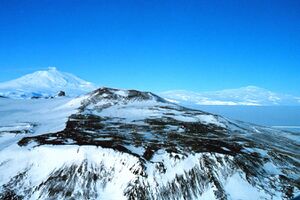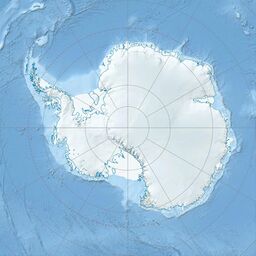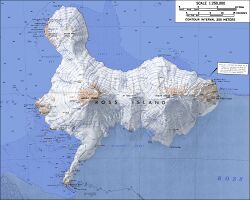Earth:Mount Terror (Antarctica)
| Mount Terror | |
|---|---|
 Mount Terror (right) and Mount Erebus (left) seen from the Hut Point Peninsula, the southernmost point on Ross Island. | |
| Highest point | |
| Elevation | 3,230 m (10,600 ft) [1] |
| Prominence | 1,728 m (5,669 ft) [2] |
| Listing | Ultra |
| Coordinates | [ ⚑ ] : 77°31′S 168°32′E / 77.517°S 168.533°E [2] |
| Geography | |
Ross Island, Antarctica | |
| Geology | |
| Age of rock | 820,000–1.75 million years |
| Mountain type | Shield volcano (extinct) |
| Volcanic belt | McMurdo Volcanic Group |
| Climbing | |
| First ascent | 1959 |
| Easiest route | snow/ice climb |
Mount Terror ( [ ⚑ ] 77°31′S 168°32′E / 77.517°S 168.533°E) is an extinct volcano about 3,230 metres (10,600 ft) high on Ross Island, Antarctica, about 20 nautical miles (37 km; 23 mi) eastward of Mount Erebus.[3] Mount Terror was named in 1841 by Sir James Clark Ross for his second ship, HMS Terror.[3] The captain of Terror was Francis Crozier, a close friend of Ross for whom the nearby Cape Crozier is named.[citation needed]
Geology
Mount Terror is a large shield volcano that forms the eastern part of Ross Island, Antarctica. It has numerous cinder cones and domes on the flanks of the shield and is mostly under snow and ice. It is the second largest of the four volcanoes that make up Ross Island and is somewhat overshadowed by its neighbour, Mount Erebus, 30 kilometres (30,000 m) to the west.[citation needed]
Geography
The rocks at the summit have not been studied, but rocks from the lower areas range from 0.82 to 1.75 million years old, and Mount Terror shows no signs of more recent volcanic activity. The first ascent of Mount Terror was made by a New Zealand party in 1959.[citation needed] The mountain is to the west of Cape Crozier, and east of Mount Erebus.[4]
Features
Features around Mount Terror include Mount Terra Nova, Cape Tennyson, Tent Peak, The Tooth, Conical Hill, Cape MacKay, Terror Point and Vee Cliffs.[4]
Terror Saddle
[ ⚑ ] 77°31′00″S 168°05′00″E / 77.5166667°S 168.0833333°E. One of three prominent snow saddles on Ross Island, located about 1,600 metres (5,200 ft) high between Mount Terra Nova and Mount Terror. Named in association with Mount Terror, which rises to 3262|m}} high to the east of this saddle.[5]
Mount Terra Nova
[ ⚑ ] 77°31′S 167°57′E / 77.517°S 167.95°E. A snow-covered mountain, 2,130 metres (6,990 ft) high, between Mount Erebus and Mount Terror. First mapped by the British National Antarctic Expedition (BrNAE) 1901-04, and named for the Terra Nova, relief ship for this expedition and the British Antarctic Expedition, 1910-13.[6]
Cape Tennyson
[ ⚑ ] 77°22′S 168°18′E / 77.367°S 168.3°E. A rock cape on the north coast of Ross Island, about 25 nautical miles (46 km; 29 mi) southeast of Cape Bird. Discovered in February 1900 by the British Antarctic Expedition, 1898–1900] under [[Carsten Borchgrevink, and named by him for English poet Alfred Tennyson.[7]
Tent Peak
[ ⚑ ] 77°30′S 168°58′E / 77.5°S 168.967°E. A tent-shaped peak rising to about 1,570 metres (5,150 ft) high midway between Mount Terror and Cape Crozier. Descriptively named by a party of the New Zealand Geological Survey Antarctic Expedition (NZGSAE), 1958-59, which occupied the peak as an astronomical control station, January 5, 1959, and erected a tent below the peak.[7]
The Tooth
[ ⚑ ] 77°31′S 168°59′E / 77.517°S 168.983°E. A distinctive rock outcrop on the eastern slopes of Mount Terror at an elevation of about 1,400 metres (4,600 ft). The feature lies 1|nmi}} south-southeast of Tent Peak and is reported to resemble a fossilized shark's tooth. Descriptively named by a party of the NZGSAE, 1958-59, working in eastern Ross Island.[8]
Conical Hill
[ ⚑ ] 77°39′S 168°34′E / 77.65°S 168.567°E. A small but distinctive rock hill, 655 metres (2,149 ft) high, on the south slopes of Mount Terror, above Cape MacKay. Given this descriptive name by the British Antarctic Expedition, 1910–13, under Scott.[9]
Cape MacKay
[ ⚑ ] 77°42′S 168°31′E / 77.7°S 168.517°E. An ice-covered cape which forms the southeast extremity of Ross Island. Discovered by the BrNAE (1901-04) and named for Captain Harry MacKay, commander of the Terra Nova, one of the relief ships for the expedition.[10]
Terror Point
[ ⚑ ] 77°41′S 168°13′E / 77.683°S 168.217°E. A point below Mount Terror. It marks the east limit of Fog Bay, 4 nautical miles (7.4 km; 4.6 mi) west-northwest of Cape MacKay. The name was first used by members of the BrNAE, 1901-04, and was apparently applied in association with Mount Terror which overlooks this point from northeastward.[3]
Fog Bay
[ ⚑ ] 77°40′S 168°10′E / 77.667°S 168.167°E. A small bay immediately west-northwest of Terror Point in Windless Bight, on the south side of Ross Island. So named by the Winter Journey Party, led by Wilson of the BrAE, 1910-13, in July 1911 because of the thick white fog they encountered in this locality.[11]
Vee Cliffs
[ ⚑ ] 77°38′S 167°45′E / 77.633°S 167.75°E. Steep, mainly ice-covered cliffs, 4 nautical miles (7.4 km; 4.6 mi) long, between Aurora and Terror Glaciers on the south shore of Ross Island. The name is suggested by two prominent V-shape wedges which protrude from the cliff wall. The name was first used by Doctor Edward A. Wilson who, with Thomas V. Hodgson of BrNAE, 1901-04, visited the cliffs in November 1903.[12]
Cultural references
- Mount Terror is the stronghold of Russian anarchist revolutionaries in the 1894 science fiction novel Olga Romanoff by George Griffith.
- Mount Terror and Mount Erebus are mentioned in the 1936 novella At the Mountains of Madness by H.P. Lovecraft.
- Mount Terror is used as a location in the 2004 novel State of Fear by Michael Crichton.
- Mount Terror is referenced in Twenty Thousand Leagues Under The Sea by the narrator Professor Arronax, after they arrive at the South Pole, in reference to two volcanic craters, the Erebus and Terror, in context to an earlier discovery by ‘’James Clark Ross’’.
See also
- List of volcanoes in Antarctica
- List of Ultras of Antarctica
References
- ↑ "Mount Terror". United States Geological Survey. https://geonames.usgs.gov/apex/f?p=gnispq:5:::NO::P5_ANTAR_ID:15152.
- ↑ 2.0 2.1 "Antarctica Ultra-Prominences" Peaklist.org. Retrieved 2012-09-05.
- ↑ 3.0 3.1 3.2 Alberts 1995, p. 740.
- ↑ 4.0 4.1 Ross Island USGS.
- ↑ Terror Saddle USGS.
- ↑ Alberts 1995, p. 739.
- ↑ 7.0 7.1 Alberts 1995, p. 738.
- ↑ Alberts 1995, p. 752.
- ↑ Alberts 1995, p. 148.
- ↑ Alberts 1995, p. 452.
- ↑ Alberts 1995, p. 248.
- ↑ Alberts 1995, p. 778.
Sources
- Alberts, Fred G., ed. (1995), Geographic Names of the Antarctic (2 ed.), United States Board on Geographic Names, https://pubs.usgs.gov/fedgov/70039167/report.pdf, retrieved 2024-01-30
 This article incorporates public domain material from websites or documents of the United States Board on Geographic Names.
This article incorporates public domain material from websites or documents of the United States Board on Geographic Names. - Ross Island, USGS: United States Geological Survey, https://commons.wikimedia.org/wiki/File:RossIslandMap.jpg, retrieved 2024-01-30
- Template:Cite gnis2
External links
 |



